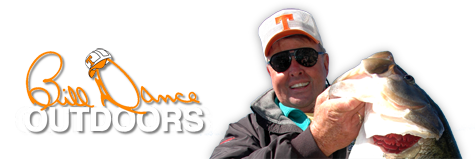Q & APosted: April 9th, 2014 by Bill Dance Welcome aboard. In this blog we are going fishing for some answers. Our first one is from a doctor in Toronto who asks: Q. When fishing for suspended bass, what type of lure do you find most effective? A. Well, first of all, suspended bass can be some of the most difficult fish to catch — simply because, when they’re suspended they’re usually in an inactive mood and don’t want to chase a lure. Bur if you can keep something appealing in their strike zone long enough, they’re much more apt to bite. Two of the most effective lures I’ve found for this situation are the Smithwick 4-1/2 suspending Rogue and Bombers suspending Excalibur Minnow. The reasons these baits work so well is first, their ability to deliver an enticing “darting” action, and second, they suspend well in between twitches on or just above the bass’s depth level. This is an unbeatable technique. But naturally, you’ll have to experiment with different sizes and colors. Here’s another frequently asked question concerning misconceptions. Q. Do fish stop biting when there’s an east wind? A. This reminds me of a saying that goes something like this, “Wind out of the East, fish bite the least! Wind from the West, fish bite the best! Wind out of the South, blows the bait in the fishes’ mouth! Wind from the North, don’t venture forth!” Well, first of all, let me be quick to tell you that the direction of the wind doesn’t directly affect fish. I’ve caught fish in wind from all directions except when it was blowing so hard I couldn’t get out, or perhaps when it was too strong to fish a particular area. However, there is some truth about the effects of wind direction which actually has its roots in barometric pressure. In other words, it deals with fronts. A strong north or east wind will generally indicate a fast weather change, therefore, a drastic change in barometric pressure. Gusty south or west winds usually indicate a slow changing weather condition; thus, minor changes in the pressure until the front nears and then a quick fall in pressure, especially during late spring, summer and early fall. So it’s not really that the wind affects fish behavior. Instead, it’s the barometric pressure that affects the wind, and this in turn affects fish behavior. Q. I’ve heard fishermen refer to an object called a deadhead. What’s a deadhead — and I’m not talking about my husband! A. A deadhead (also called a deadfall) is a fallen tree that has floated for some time. At some point, one end of the tree has become waterlogged and either sunk to the bottom or hung up along a ledge or in other submerged cover. Recognize that wind and currents will shift deadheads around until they become dislodged and move, or they will sink from becoming too waterlogged. Consequently, they may not always be in the same place that you found them a few days ago. Any type of deadhead is an excellent place to locate bass, but a deadhead that is wedged along a drop is always better. Never pass these up. Single bass will hang around the exposed end near the surface and concentrations of fish often hold in the thick cover below. Sometimes the deadhead will position itself in the opposite direction. Here you will usually find fish suspended in the heavier cover located near the surface. Now here’s an additional tip that you’ll want to remember. When the water begins to warm in the spring, bass will suspend around a deadhead and the exposed end serves as a great ambush point where bass can attack baitfish as they meander by. At this point you might be asking yourself, “What type lures are best for fishing deadheads?” Several lures are good. The time of the year and the water clarity will determine the choices. For muddy water, during late spring and early summer, I prefer a buzzbait and a spinnerbait. If the limbs on the deadhead aren’t too deep, a crankbait, fished slowly is tops. In clear water during the spring and summer, fish a crankbait parallel to the deadhead. Try a buzzbait or spinnerbait near the exposed top and a jig ’n’eel or plastic lizard or worm, deeper. In mid-summer, the plastic worm is best in most cases. And don’t overlook topwater baits early and late in the day and when the sky is cloudy. As always, catch one for me!
|
Upload your trophy bass photo (or any other fish) to BillDanceOutdoors.com! Or, post comments about other photos submitted by Bill Dance fans.
Bill Dance is one of the most recognizable names and brands in fishing and outdoor gear. Please browse through our selection of superior products that proudly carry the Bill Dance name.
|





